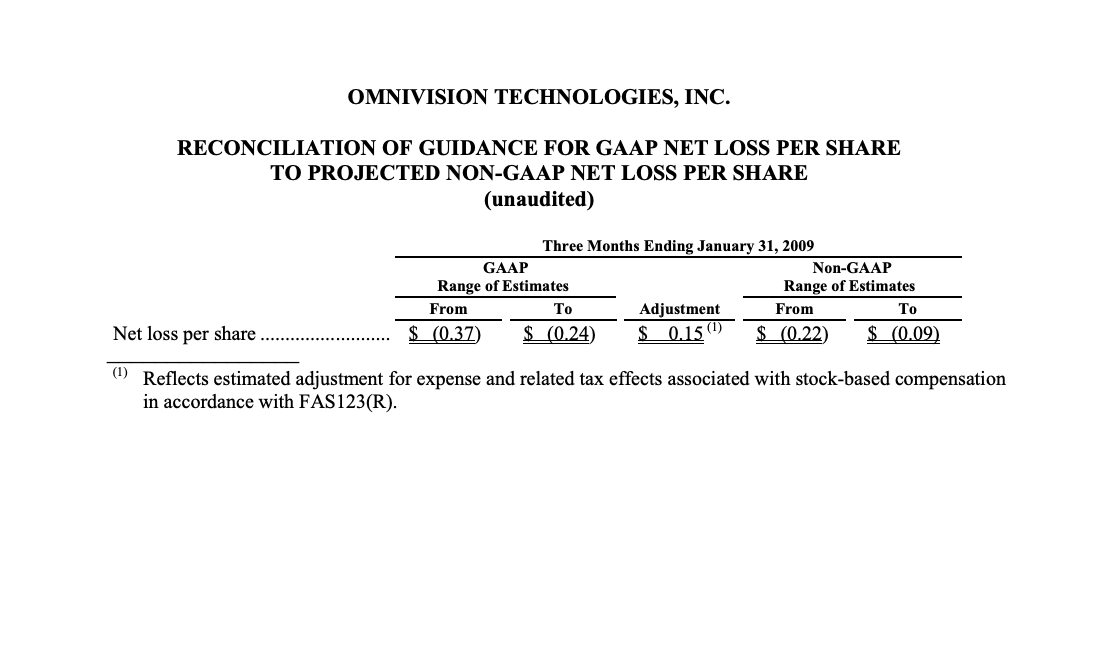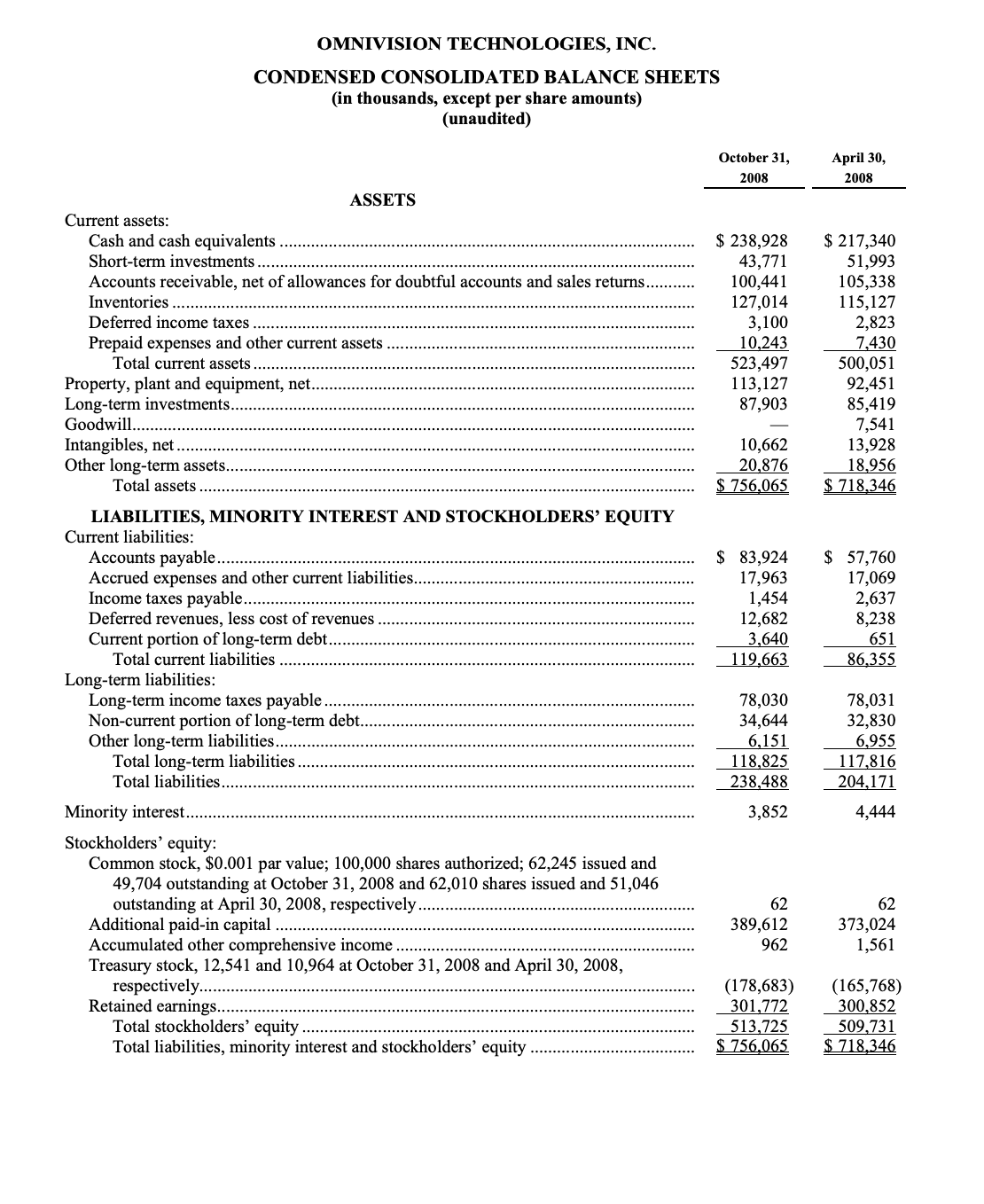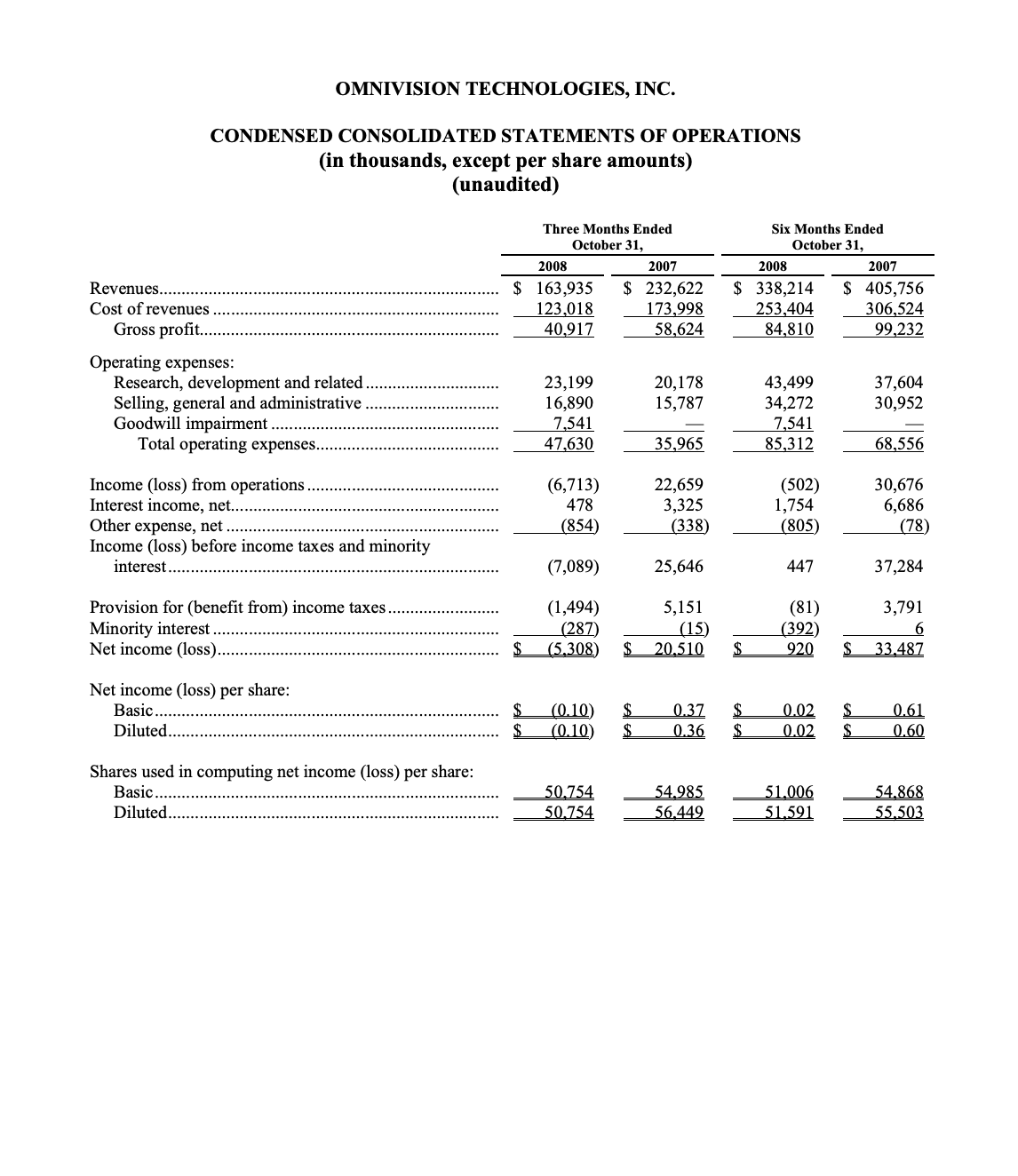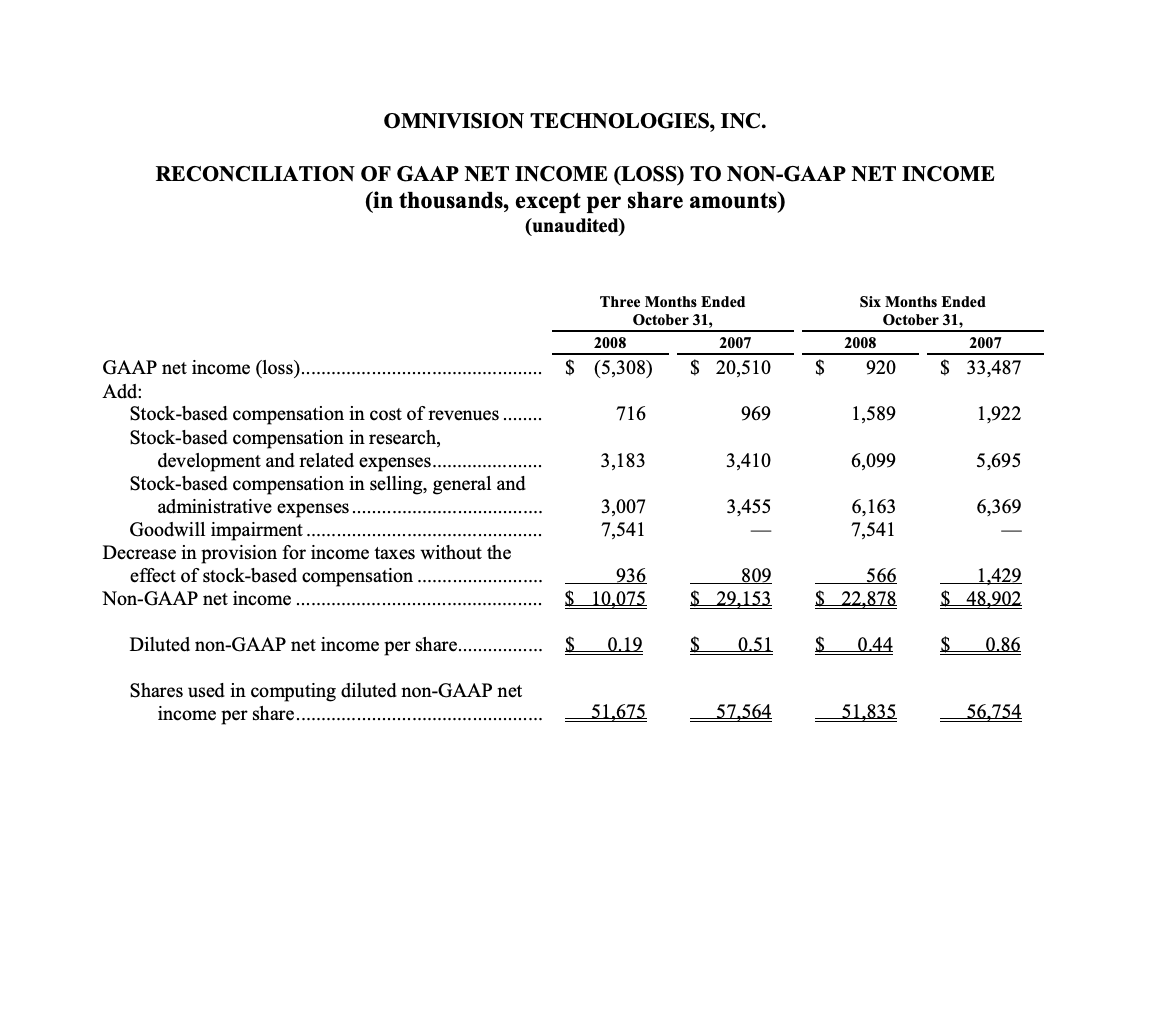Santa Clara, California, December 2, 2008 – OmniVision Technologies, Inc. (Nasdaq: OVTI), a leading supplier of CMOS image sensors, today reported financial results for the second fiscal quarter ended October 31, 2008.
Revenues for the second quarter of fiscal 2009 were $163.9 million, as compared to $174.3 million in the first quarter of fiscal 2009, and $232.6 million in the second quarter of fiscal 2008.
During the second quarter of fiscal 2009, the Company performed a goodwill impairment analysis in accordance with FAS 142. The Company would normally test its goodwill for impairment at year-end. However, the significant decline in the Company’s market capitalization and the current economic downturn prompted management to perform an interim impairment analysis. Based on the work performed to date, the Company concluded that an impairment loss is probable and estimable. As a result, the Company recorded an impairment charge of $7.5 million of its goodwill. The Company did not record any impairment of its intangible assets or its other long-lived assets.
GAAP net loss in the second quarter of fiscal 2009, which includes stock-based compensation expense and the related tax effects under FAS 123(R) and the goodwill impairment charge, was $5.3 million, or $0.10 per share, as compared to net income of $6.2 million, or $0.12 per diluted share, in the first quarter of fiscal 2009, and $20.5 million, or $0.36 per diluted share in the second quarter of fiscal 2008.
Non-GAAP net income in the second quarter of fiscal 2009, which excludes stock-based compensation expense and the related tax effects under FAS 123(R) and the goodwill impairment charge, was $10.1 million and non-GAAP earnings were $0.19 per diluted share. Non-GAAP net income in the first quarter of fiscal 2009, which excludes stock-based compensation expense and the related tax effects under FAS 123(R), was $12.8 million and non- GAAP earnings were $0.25 per diluted share. Non-GAAP net income in the second quarter of fiscal 2008, which excludes stock-based compensation expense and the related tax effects, was $29.2 million and non-GAAP earnings were $0.51 per diluted share. Refer to the attached schedule for a reconciliation of GAAP net income (loss) to non-GAAP net income for the three and six months ended October 31, 2008 and 2007.
Gross margin for the second quarter of fiscal 2009 was 25.0% as compared to 25.2% for the first quarter of fiscal 2009 and 25.2% for the second quarter of fiscal 2008. The decrease in gross margin resulted primarily from the recognition of additional allowances for inventories, partially offset by a more favorable product mix and higher average selling prices than in the first quarter of fiscal 2009.
The Company ended the period with cash, cash equivalents and short-term investments totaling $282.7 million, an increase of $3.3 million from the previous quarter. The increase reflects favorable cash flow from operations during the quarter, partially offset by approximately $12.9 million in cash used for the repurchase of the Company’s common stock.
“During the second quarter, we continued to see higher penetration of cameras into notebook computers and the transition to higher resolution cameras in phones with two megapixel and above sensors representing the highest percentage of revenue in our history,” said Shaw Hong, OmniVision’s president and chief executive officer.
“Separately, we are closely monitoring industry and economic conditions during these difficult financial times, and are focused on being able to deliver market leading technologies and products in the most cost-effective manner possible,” Mr. Hong concluded.
Outlook
Based on current trends, the Company expects fiscal third quarter 2009 revenues will be in the range of $80 million to $100 million and GAAP net loss will be between $0.37 and $0.24 per share. Excluding the estimated expense and related tax effects associated with stock-based compensation, the Company expects its non-GAAP net loss will be between $0.22 and $0.09 per share. Refer to the table below for a reconciliation of GAAP to non-GAAP net income.
Conference Call
OmniVision Technologies will host a conference call today at 2:00 p.m. Pacific Time to discuss these results further. This conference call can be accessed via a webcast at www.ovt.com. The call can also be accessed by dialing 888-396-2298 or 617-847-8708 and enter passcode 78500592.
A replay of the call will remain available at www.ovt.com for approximately twelve months. A replay of the call will also be available for 48 hours beginning approximately one hour after the call. To access the replay, dial 888-286-8010 or 617-801-6888 and enter passcode 62665525.
Safe Harbor Statement
Certain statements in this press release, including statements relating to the Company’s expectations regarding revenues and earnings per share for the three months ending January 31, 2009 are forward-looking statements. These forward-looking statements are based on management’s current expectations, and certain factors could cause actual results to differ materially from those in the forward-looking statements. These factors include, without limitation, competition in current and emerging markets for image sensor products, including pricing pressures that could result from competition; the Company’s ability to obtain design wins from various image sensor device manufacturers including manufacturers of mobile phone, laptops and PCs, digital still cameras and automobile manufacturers; the market acceptance of products into which the Company’s products are designed; the potential impact of general economic conditions, wafer manufacturing yields and other manufacturing processes; the Company’s ability to accurately forecast customer demand for its products; the development, production, introduction and marketing of new products and technology; the potential loss of one or more key customers or distributors; the continued growth and development of current markets and the emergence of new markets in which the Company sells, or may sell, its products; the acceptance of the Company’s products in such current and new markets; the Company’s strategic investments and relationships, and other risks detailed from time to time in the Company’s Securities and Exchange Commission filings and reports, including, but not limited to, the Company’s most recent Annual Report on Form 10-K and most recent Quarterly Report on Form 10-Q. The Company expressly disclaims any obligation to update information contained in any forward-looking statement.
Use of Non-GAAP Financial Information
To supplement the reader’s overall understanding both of its reported results presented in accordance with U.S. generally accepted accounting principles (“GAAP”) and its outlook, the Company also presents non-GAAP measures of net income and earnings per share which are adjusted from results based on GAAP. In particular, the Company excludes stock-based compensation expense under FAS 123(R) and the related tax effects and the goodwill impairment charge recognized in the second quarter of fiscal 2009. The non-GAAP financial measures which the Company discloses also exclude the effects of FAS 123(R) on the number of diluted common shares used in calculating non-GAAP diluted earnings per share. The Company provides these non-GAAP financial measures to enhance an investor’s overall understanding of its current financial performance and to assess its prospects for the future. These non-GAAP financial measures reflect an additional way of viewing aspects of the Company’s operations that, when viewed with its GAAP results and the accompanying reconciliations to the corresponding GAAP financial measures, provide a more complete understanding of factors and trends affecting the Company’s business. The economic basis for the Company’s decision to use non-GAAP financial measures is that the adjustments to net income did not reflect the on-going relative strength of its performance. The Company’s objective is to minimize any confusion in the financial markets by providing non-GAAP net income and non-GAAP earnings per share measurements and disclosing the related components. These non-GAAP financial measures should be considered as a supplement to, and not as a substitute for, or superior to, the financial measures prepared in accordance with GAAP statements.
The Company uses non-GAAP financial measures for internal management purposes to conduct and evaluate its business, when publicly providing its business outlook and to facilitate period-to-period comparisons. The Company views non-GAAP net income per share as a primary indicator of the profitability of its underlying business. In addition, because stock-based compensation is a non-cash expense and is offset in full by a credit to paid-in capital, it has no effect on total stockholders’ equity. As the calculation of non-GAAP financial measures differ between companies, the non-GAAP financial measures used by the Company may not be comparable to similarly titled measures used by other companies. Other than stock-based compensation, these differences may cause the Company’s non-GAAP measures to not be directly comparable to other companies’ non-GAAP measures. Although these non-GAAP financial measures adjust cost, expenses and diluted share items to exclude the accounting treatment of stock-based compensation, they should not be viewed as a non-GAAP presentation reflecting the elimination of the underlying stock-based compensation programs. Thus, the Company’s non-GAAP presentations are not intended to present, and should not be used, as a basis for assessing what its operating results might be if it were to eliminate its stock-based compensation programs. The Company compensates for these limitations by providing full disclosure of the net income and earnings per share on a basis prepared in accordance with GAAP to enable investors to consider net income and earnings per share determined under GAAP as well as on an adjusted basis, and perform their own analysis, as appropriate. As a result of the foregoing limitations, the Company does not use, nor does the Company intend to use, the non-GAAP financial measures when assessing the Company’s performance against that of other companies.
Estimating stock-based compensation expense and the related tax effects for a future period is subject to inherent risks and uncertainties, including but not limited to the price of the Company’s stock and the number of option exercises and sales during the quarter.




